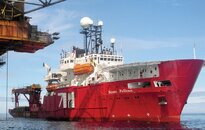If you are interested:
Maybe there's more that goes into it (?) but I've always called it "saturation diving" / "saturation suit", or as Don said, "hard hat diving". The suit you have on in your avatar, is that basically the same thing, just modern? I lost my Mark V keychain yesterday, I'm pretty bummed! It's like the 6th one I've lost!!
The gear in the OP was developed by
Augustus Siebe in the 1830s. Air continuously flowed, there was no demand regulator though some divers had tried jury-rigging one into a hat in the late 1950s and early 60s. To my knowledge, the classic spun-copper free-flow helmet and attached drysuit (or "dress") has never been used except for surfaced-supplied diving.
Saturation diving was developed by the US Navy’s Captain George Bond (affectionately known as Papa Topside) in the 1960s. All divers know that the deeper we go and longer we stay, the longer decompression will be. That is true until we stay long enough for our tissues to become fully saturated, as they are normally as sea level. At that point decompression times no longer increase. Theoretical saturation time is about 24 hours. As a result, it does not matter if you stay 24 hours, 24 days, or 24 months, the decompression time is the same. Typical sats are 2-4 weeks on the bottom (plus decompression) or until the job is done. Many jobs last much longer so crews are swapped out through various chambers connected to the complex.
You hear about some habitat-based scientific saturation dives but they are relatively shallow and rare. Sat crews live in chambers on deck pressurized to their holding depth, typically at the shallow range of their working depth. They transfer to the work site via a diving bell, lock out, and typically spend 6-12 hours between crew changes. They all wear lightweight hats and hot water suits breathing HeO
2 mixtures typically between .3 to .8 ATA O
2, almost always using a closed-circuit surface-based recirculating system to conserve gas.
Search Saturation Diving on YouTube, there are lots of videos. I never realized that people might confuse the oldest diving gear (after breath-holding) with the most advanced and sophisticated diving. Here is an image of a typical North Sea saturation diving support vessel.

She is 94 Meters long x 18 Meters wide, supports 18 divers in sat to 370 Meters (1,214 FSW) with two bells and a ROV (Remotely Operated Vehicle). Onboard gas is measured in hundreds of thousands of cubic feet.

 For those interested, this is a US Navy Mark V Helium Hat.
For those interested, this is a US Navy Mark V Helium Hat.



